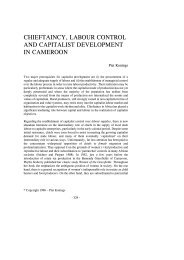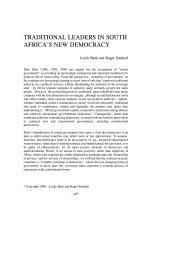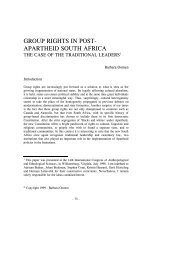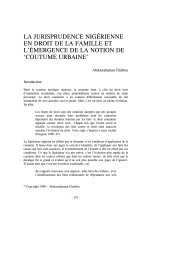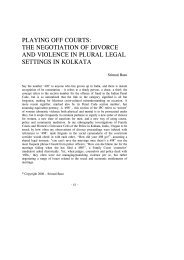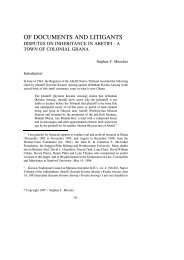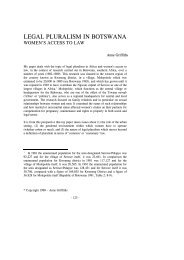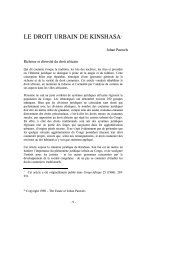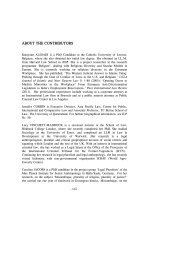article (pdf) - Journal of Legal Pluralism
article (pdf) - Journal of Legal Pluralism
article (pdf) - Journal of Legal Pluralism
Create successful ePaper yourself
Turn your PDF publications into a flip-book with our unique Google optimized e-Paper software.
INTRODUCTION<br />
Carol LaPrairie<br />
In his essay in this volume Robert Depew writes that the communitarian tradition <strong>of</strong><br />
justice, known more commonly as popular justice,<br />
embraces an ideology and assumption set which promise a quality <strong>of</strong> justice and a<br />
range <strong>of</strong> related practical benefits that cannot be achieved or are difficult to achieve<br />
through the more conventional, formal justice apparatus <strong>of</strong> the State.<br />
The desire to explore this ideology and these assumptions further, and to examine the<br />
practical consequences <strong>of</strong> popular justice from an international perspective provided<br />
the impetus for this special issue <strong>of</strong> the <strong>Journal</strong> <strong>of</strong> <strong>Legal</strong> <strong>Pluralism</strong>. We make<br />
reference to the concept <strong>of</strong> 'popular' rather than 'community' justice as the former<br />
incorporates an ideology and set <strong>of</strong> assumptions which the term 'community' does not<br />
explicitly include.<br />
The volume is framed by the following questions: What is the meaning <strong>of</strong> popular<br />
justice? What is the genesis <strong>of</strong> the popular justice movement? What is the future <strong>of</strong><br />
popular justice? In this introduction we expand upon these questions to provide a<br />
framework for reading the diverse range <strong>of</strong> papers which follow. Because the term<br />
'popular justice' wears many hats and has become a catch-all phrase to denote<br />
anything not <strong>of</strong> the formal, adversarial criminal justice system, we feel it important to<br />
provide a context for the papers. These questions are integral to each <strong>of</strong> them,<br />
although each also deals with a specific subject <strong>of</strong> popular justice. Each <strong>of</strong> the<br />
questions which frame the volume is considered in turn below.<br />
What is the meaning <strong>of</strong> Popular Justice?<br />
In a recent <strong>article</strong> Stanley Cohen sets out some ways <strong>of</strong> thinking about social<br />
control. He maintains that there are three different traditions <strong>of</strong> thought or<br />
© Copyright 1996 - Carol LaPrairie.<br />
− 1 −
INTRODUCTION<br />
Carol LaPrairie<br />
discourses about the subject. The first is political, and deals with order, legitimacy<br />
and authority and confronts the central problem <strong>of</strong> how to achieve a degree <strong>of</strong> order,<br />
regulation and stability not inconsistent with the maintenance <strong>of</strong> individual liberty; the<br />
second is anthropological, and involves the search for the variation in content <strong>of</strong> the<br />
universal process <strong>of</strong> socialization, conformity, internalization <strong>of</strong> norms,<br />
value-consensus; and the third is concerned with deviance and crime, and deals with<br />
the organized, patterned responses to the normative violations which become<br />
categorized as crime. Cohen argues that we are now at the fascinating stage where<br />
these three discourses are becoming less separate and the interfaces between them<br />
more apparent.<br />
Within each discourse are various modes <strong>of</strong> social control, namely the punitive,<br />
compensatory, conciliatory and therapeutic. It is within the compensatory and the<br />
conciliatory modes that popular justice is located. In the political discourse, terms<br />
such as community justice, popular justice or people's courts are used; in the<br />
anthropological, references to the universal, natural, organic forms <strong>of</strong> control, are to<br />
be found; in the crime/deviance mode, informal social control, community control,<br />
and abolitionism are terms which abound. It is less frequently noted that popular<br />
justice can use punishment as easily as reconciliation, and that conversely modes such<br />
as compensation and reconciliation can be found in many state or bureaucratic<br />
institutions (Cohen 1994: 64-65).<br />
In the compensatory and conciliatory modes <strong>of</strong> social control the emphasis is on<br />
social rather than legal justice; the objective is to place justice in a context where<br />
damage and not guilt is seen as important. Braithwaite (1994) argues that a challenge<br />
for a communitarian approach to justice is to determine how community power can<br />
replace or co-opt state power. These modes <strong>of</strong> social control rely heavily on the<br />
empowerment <strong>of</strong> individuals and communities where the goal is to work together to<br />
negotiate mutually acceptable outcomes and where blame is shared (Cohen 1994: 68).<br />
Depew's paper is particularly helpful in describing the psychological and<br />
organizational objectives <strong>of</strong> popular justice and its vast appeal in terms <strong>of</strong> its more<br />
'human' elements. Its emphasis on social rather than legal factors (Justice Fellowship<br />
1989) lends support to the view that popular justice gives more attention to real<br />
problems and has the potential to achieve more useful, longer term solutions to these<br />
problems.<br />
What is the genesis <strong>of</strong> popular justice?<br />
A desire to exercise greater local control over disputes is part <strong>of</strong> a broader<br />
movement toward minimal intervention <strong>of</strong> the State, and toward informality. It is<br />
also part <strong>of</strong> the victims' rights movement where the State is seen as indifferent to<br />
victims and local systems as more inclusive and more capable <strong>of</strong> resolving<br />
− 2 −
JOURNAL OF LEGAL PLURALISM<br />
1996 - nr. 36<br />
problems <strong>of</strong> communication and individual conflict. Popular justice has emerged<br />
within what might be termed the 'participation paradigm', where in some respects<br />
justice has become 'everybody's business' (Shearing 1993) and where community is<br />
paramount. Inherent in this new definition and understanding <strong>of</strong> justice is a new legal<br />
pluralism. This involves the recognition <strong>of</strong> different legal orders where local orders<br />
co-exist with the state, while maintaining a degree <strong>of</strong> autonomy and ensuring that the<br />
state monopoly <strong>of</strong> law is not absolute at the community level, as Nina and<br />
Schwikkard note.<br />
Popular justice has also become more 'popular' under the influence <strong>of</strong><br />
post-modernism with its emphasis on individual expressions <strong>of</strong> identity and culture.<br />
Here popular justice becomes a vehicle for 'moments <strong>of</strong> resistance' and features "as<br />
part <strong>of</strong> a larger movement, most <strong>of</strong>ten about transformative politics" (Merry 1995).<br />
This is particularly evident in Canada, where individual expression has defined the<br />
aboriginal criminal justice discourse and where today empirical research is sometimes<br />
replaced by 'worldview' (LaPrairie 1996). This, as Depew notes, may in fact be an<br />
ideology, but when it is presented as a worldview any challenge to its validity is<br />
inhibited. It is important, therefore, to keep in mind that expressions <strong>of</strong> popular<br />
justice may become a vehicle for necessary political change and for expressions <strong>of</strong><br />
'empowerment', but may also be used as a vehicle for hegemonic domination <strong>of</strong> a<br />
discourse.<br />
At the more specific level <strong>of</strong> criminal justice, there is a widespread belief that the<br />
present system does not rehabilitate people, that victims are unjustly excluded, and<br />
that a reliance on prisons makes people worse and not better. In attempting to redress<br />
these defects there is a move toward sharing responsibility for crime more widely,<br />
towards the demystification <strong>of</strong> the state system through the use <strong>of</strong> informal<br />
community mechanisms, and towards giving more power to victims and communities<br />
(Justice Fellowship 1989). Empowerment and the belief in the need to 'restore'<br />
relationships between <strong>of</strong>fenders, victims and communities, are central . The popular<br />
justice discourse, especially where it interacts with customary or traditional,<br />
indigenous forms <strong>of</strong> justice, suggests a return to the roles and relationships between<br />
groups and individuals which characterize less complex and more communal<br />
societies. Regardless <strong>of</strong> the merit <strong>of</strong> this belief, there is an ideology attached to<br />
popular justice which it is virtually impossible for the state system to satisfy.<br />
The papers by Depew, Crnkovich and Clairmont in this volume all speak <strong>of</strong><br />
aboriginal criminal justice against the background <strong>of</strong> demands by aboriginal<br />
groups in Canada to move from the adversarial system <strong>of</strong> dispute resolution and<br />
adjudication in criminal cases to a system in which victims, families and<br />
communities will play a greater role. This is also the case in Australia and New<br />
Zealand where a variety <strong>of</strong> community forms <strong>of</strong> criminal justice is emerging.<br />
− 3 −
INTRODUCTION<br />
Carol LaPrairie<br />
Some <strong>of</strong> these are aboriginal-inspired, such as Family Group Conferencing for<br />
dealing with young <strong>of</strong>fenders in New Zealand. There is a variety <strong>of</strong> local initiatives,<br />
<strong>of</strong>ten involving aspects <strong>of</strong> customary law, in Australia. There is a distinct move<br />
towards the adoption <strong>of</strong> popular justice (<strong>of</strong>ten defined as 'restorative justice'), in<br />
which the restoration <strong>of</strong> bonds between people is the goal. In this context popular<br />
justice has emerged as a demand by aboriginal people as part <strong>of</strong> a larger First Nation<br />
political agenda.<br />
What is the future <strong>of</strong> popular justice?<br />
In many respects this is the question which is the most relevant to the <strong>article</strong>s in this<br />
volume, because they provide examples <strong>of</strong> the 'practice <strong>of</strong> popular justice'. Some <strong>of</strong><br />
the papers, such as those by Anne Griffiths, George Westermark and Mary<br />
Crnkovich, are case studies; others, such as that by Donald Clairmont, provide<br />
information and analysis <strong>of</strong> certain approaches undertaken within an accommodating<br />
and supportive political climate; yet others, such as that by Nina and Schwikkard,<br />
describe the machinery <strong>of</strong> popular justice.<br />
Perhaps the most important conclusion we can reach from a study <strong>of</strong> the <strong>article</strong>s in<br />
this volume and elsewhere (see Merry 1990; Gordon and Meggitt 1985; Nader 1993)<br />
is that informal justice is not a panacea for all our justice problems any more than is<br />
formal, state justice. As Depew notes, the type <strong>of</strong> case and characteristics <strong>of</strong><br />
disputants strongly influence the use and effectiveness <strong>of</strong> popular justice<br />
interventions. In assessing the value <strong>of</strong> informal justice approaches it is also necessary<br />
to note its relation to the degree <strong>of</strong> mutual dependence among community members.<br />
An overly idealized vision <strong>of</strong> 'community' and its ability to understand the nature <strong>of</strong><br />
its problems and readily to find solutions, given the power and opportunity, may lead<br />
to disappointment and frustration with popular justice. It is interesting that, as we<br />
becoming increasingly sophisticated in some areas such as technology and genetics,<br />
we become increasingly simplistic in others such as justice.<br />
At the same time, however, it is important to remain open to the other merits <strong>of</strong><br />
alternative approaches to dealing with disputes between people, crime and disorder.<br />
Some <strong>of</strong> these, while not providing solutions to social problems, still do less harm<br />
than the state's traditional reliance on police, courts and prisons. Perhaps the real<br />
value <strong>of</strong> popular justice lies in its potential for doing less harm both between and to<br />
people. It is with regard to this possibility, as well as with a view simply to providing<br />
current information and analyses <strong>of</strong> popular justice from an international perspective,<br />
that we have compiled this collection. Let us turn now to the content <strong>of</strong> this issue.<br />
− 4 −
JOURNAL OF LEGAL PLURALISM<br />
1996 - nr. 36<br />
The Papers<br />
Robert Depew's paper "Popular justice and aboriginal communities: some<br />
preliminary considerations", is particularly useful in setting out the range <strong>of</strong> popular<br />
justice issues, and providing a broader framework for understanding the meaning,<br />
genesis and future <strong>of</strong> popular justice. Hence we are presenting it as the lead <strong>article</strong>.<br />
The author travels from a broad description <strong>of</strong> popular justice using the general<br />
literature, to the relevant aboriginal issues and context. He raises some <strong>of</strong> the critical<br />
but <strong>of</strong>ten ignored issues about the state <strong>of</strong> aboriginal communities, looking beyond the<br />
common description and perception <strong>of</strong> popular justice as the panacea to all their<br />
problems.<br />
This is followed by "The 's<strong>of</strong>t vengeance' <strong>of</strong> the people: popular justice, community<br />
justice and legal pluralism in South Africa", in which Daniel Nina and Pamela Jane<br />
Schwikkard describe the value <strong>of</strong> popular justice in moving communities to define<br />
their own legal needs. The authors provide a particularly insightful account <strong>of</strong> the<br />
various forms <strong>of</strong> accommodation between community and state justice in their<br />
discussion <strong>of</strong> popular justice and legal pluralism in South Africa. They describe the<br />
communities which they sought to assist in the process <strong>of</strong> 'self-regulation', i.e., in the<br />
development <strong>of</strong> their own structures <strong>of</strong> conflict resolution and legal ordering. This<br />
type <strong>of</strong> move to self-regulation does not deny the authority <strong>of</strong> state law but<br />
contributes to the maintenance <strong>of</strong> local order. After presenting examples <strong>of</strong><br />
self-regulation, Nina and Schwikkard conclude that popular justice will not disappear.<br />
It is perceived not only as an effective tool <strong>of</strong> empowerment, but as a significant<br />
contribution to the process <strong>of</strong> consolidating a democratic and fair society.<br />
In his paper on approaches to development and the construction <strong>of</strong> identities, "The<br />
multiple faces <strong>of</strong> the ideology <strong>of</strong> intervention: a story <strong>of</strong> administrators' fantasies and<br />
implementors' anxieties", Pieter de Vries provides an important insight: that<br />
community justice needs to reflect the realities <strong>of</strong> those who are most affected by<br />
activities that purport to serve that community. He describes a rural development<br />
project in Costa Rica and demonstrates how the realities <strong>of</strong> the community <strong>of</strong> people<br />
most affected by development, i.e., local farmers, are marginalized in the definitions<br />
<strong>of</strong> development and in the categorisation <strong>of</strong> them as clients, formulated by frontline<br />
workers and bureaucrats. The ideology <strong>of</strong> intervention derives its power from its<br />
usefulness for accomplishing bureaucratic tasks through the conversion <strong>of</strong> rural<br />
people into bureaucratic subjects. The author's account provides an example <strong>of</strong> the<br />
necessity for popular justice to reflect the needs and realities <strong>of</strong> the client group if it is<br />
to remain viable for those it purports to serve, and to meet the 'empowerment'<br />
objectives <strong>of</strong> popular justice.<br />
In the next paper, "The Rise <strong>of</strong> the Rondas Campesinas in Peru", German Nuñez<br />
− 5 −
INTRODUCTION<br />
Carol LaPrairie<br />
Palomino provides an engaging account <strong>of</strong> the emergence <strong>of</strong> the rondas campesinas<br />
(peasant rounds), organs <strong>of</strong> popular justice originating in the Inca empire. He<br />
describes how these re-emerged in more recent times in response to a problem with<br />
cattle rustling and how they have expanded from local groups with a specific purpose<br />
to country-wide instruments <strong>of</strong> social control and dispute resolution, while at the<br />
same time maintaining their most characteristic features as authentic peasant<br />
organizations. In their contemporary form the rounds deal with all types <strong>of</strong> criminal<br />
and civil claims. They also sanction those who commit criminal acts. A particularly<br />
interesting function in the light <strong>of</strong> the experience reported by de Vries in Costa Rica,<br />
is that the rondas campesinas in Peru also are involved in the regulation <strong>of</strong> communal<br />
development. A loss <strong>of</strong> legitimacy <strong>of</strong> the rounds in the peasant communities resulted,<br />
in part, from attempts by state government to undermine them in the 1970s.<br />
Subsequently there have been changes and improvements in the relationship between<br />
rounds and <strong>of</strong>ficial authorities. The road to <strong>of</strong>ficial recognition has been long and<br />
difficult, but in 1986 they received <strong>of</strong>ficial recognition in state legislation.<br />
We move next to another two Canadian papers. The high representation in the<br />
volume <strong>of</strong> Canadian papers is not by accident. We felt that the advanced state <strong>of</strong><br />
aboriginal self-government and aboriginal justice activities in that country, in<br />
comparison to others with similar indigenous populations, justified the devotion <strong>of</strong><br />
more space to the Canadian example. The papers by Robert Depew, Donald<br />
Clairmont and Mary Crnkovich provide a good overview <strong>of</strong> the state <strong>of</strong> popular<br />
justice in aboriginal communities in Canada. It is essential to consider the issues<br />
these papers raise if we are to develop an understanding <strong>of</strong> the future <strong>of</strong> popular<br />
justice, not only in Canada, but in other countries with similar interests in popular<br />
justice.<br />
In contrast to Depew's theoretical analysis <strong>of</strong> the implications <strong>of</strong> popular justice for<br />
aboriginal people and communities in Canada, Donald Clairmont, in "Alternative<br />
Justice Issues for Aboriginal Justice", provides more <strong>of</strong> a micro-level analysis <strong>of</strong><br />
specific community justice projects. The projects are presently functioning in<br />
communities that vary in geography and size.<br />
Clairmont's paper situates the community justice activities within the broader<br />
political and aboriginal criminal justice contexts. He provides four examples <strong>of</strong><br />
community projects and locates their source in aboriginal political demands for<br />
greater control over justice in communities, but ties them as well to the need for<br />
institution-building in communities. He gives us information about the projects<br />
from the perspective <strong>of</strong> a number <strong>of</strong> community players, including community<br />
members, <strong>of</strong>ficials, <strong>of</strong>fenders and victims. He concludes that, while these projects<br />
have many attractions from a community and self-government perspective and<br />
well may "constitute a flagship for change in the justice field", they require more<br />
− 6 −
JOURNAL OF LEGAL PLURALISM<br />
1996 - nr. 36<br />
time and analysis before any firm conclusions about their immediate and long-term<br />
value to communities can be reached.<br />
In contrast to the broader approach <strong>of</strong> Depew and the overview <strong>of</strong> community<br />
projects by Clairmont, Mary Crnkovich in her "A Sentencing Circle" takes us on a<br />
different journey in her fascinating account <strong>of</strong> one family violence case in a northern<br />
Quebec Inuit community where a community circle was used to determine the<br />
sentence. The most compelling part <strong>of</strong> her description is her account <strong>of</strong> the views <strong>of</strong><br />
the various players, contrasting the judge and the community, the <strong>of</strong>fender and the<br />
victim. Perhaps her account <strong>of</strong> this case provides the most vivid demonstration <strong>of</strong><br />
some <strong>of</strong> the contradictions between, on the one hand, the discourse and the rhetoric,<br />
and, on the other, the reality <strong>of</strong> popular justice. Her <strong>article</strong> is particularly useful in<br />
demonstrating how popular justice may be adopted by mainstream justice <strong>of</strong>ficials in<br />
the belief that it is more appropriate for the community, even though the needs <strong>of</strong> the<br />
individual most affected - the victim - are compromised.<br />
The assumption that a return to a more customary local system <strong>of</strong> justice will be<br />
permanent and transcend any social and economic change is challenged in the paper<br />
by George Westermark, "When the alternative fails". In his careful analysis <strong>of</strong> the<br />
genesis and functioning <strong>of</strong> the village courts in Papua New Guinea in the '70s and<br />
'80s, Westermark documents the effects <strong>of</strong> a desire for a popular justice system with<br />
a status comparable with that <strong>of</strong> the state system, in combination with a lack <strong>of</strong><br />
government support, and the alteration <strong>of</strong> local life through global economic and<br />
religious changes. He shows how these factors modified the sources <strong>of</strong> and responses<br />
to conflict in the communities and reduced the general reliance on the village court<br />
system.<br />
The Westermark paper is complemented by the contribution <strong>of</strong> Anne Griffiths who,<br />
from extensive field work in Botswana, details the functioning <strong>of</strong> a state Magistrate's<br />
court and the local Chief's kgotla as two apparently opposite forms <strong>of</strong> justice in<br />
"Between paradigms: differing perspectives on justice in Molepolole Botswana". She<br />
concludes that many <strong>of</strong> the assumptions about the differences between popular and<br />
state justice cannot be upheld. Popular justice forums may be just as inflexible as<br />
those <strong>of</strong> the state, and it is difficult if not impossible to prevent the intrusion <strong>of</strong> state<br />
power into local systems. Perhaps her most compelling conclusion is that popular<br />
justice should be explored beyond the confines <strong>of</strong> legal institutions. We need to move<br />
into the realm <strong>of</strong> other bodies and agencies which construct social relations,<br />
particularly in cases involving gender and power.<br />
We hope that the collection <strong>of</strong> papers in this volume will tell the reader something<br />
about the concepts and contradictions <strong>of</strong> popular justice. Our aim has been also,<br />
− 7 −
INTRODUCTION<br />
Carol LaPrairie<br />
by presenting an international perspective, to make apparent the richness and<br />
diversity <strong>of</strong> popular justice projects. We hope that the reader finds our selection <strong>of</strong><br />
<strong>article</strong>s as interesting and stimulating as the editors found them when receiving and<br />
reviewing them. To all the authors we extend our sincerest appreciation for their<br />
contributions.<br />
References<br />
BRAITHWAITE, John<br />
1994 "Thinking harder about democratising social control." Pp. 199-216 in<br />
Christine Adler and Joy Wundersitz (eds.), Family Conferencing and<br />
Juvenile Justice: The Way Forward or Misplaced Optimism?, Australian<br />
Studies in Law, Crime and Justice.<br />
COHEN, Stanley<br />
1994 "Social control and the politics <strong>of</strong> reconstruction." Pp. 63-88 in David<br />
Nelken (ed.), The Futures <strong>of</strong> Criminology, London: Sage Publications.<br />
GORDON, Robert J. and Mervyn J. MEGGITT<br />
1985 Law and order in New Guinea Highlands: Encounters with Enaa.<br />
University Press <strong>of</strong> New England.<br />
JUSTICE FELLOWSHIP<br />
1989 Restorative Justice: Theory. Principles. Practice. Washington, D.C.:<br />
Fellowship Communications.<br />
LAPRAIRIE, Carol with Phil MUN<br />
1996 The State <strong>of</strong> Aboriginal Corrections. Ottawa: Ministry <strong>of</strong> the Solicitor<br />
General (forthcoming).<br />
MERRY, Sally Engle<br />
1990 Getting Justice and Getting Even: <strong>Legal</strong> Consciousness among Working<br />
Class Americans. Chicago: University <strong>of</strong> Chicago Press.<br />
1995 "Resistance and the cultural power <strong>of</strong> law." Law and Society Review 29:<br />
11-26.<br />
MERRY, Sally Engle and Neal MILNER (eds.)<br />
1993 The Possibility <strong>of</strong> Popular Justice: A Case Study <strong>of</strong> Communities<br />
Mediation in the United States. Ann Arbor: University <strong>of</strong> Michigan<br />
Press.<br />
NADER, Laura<br />
1993 "When is popular justice popular?" Pp. 435-452 in Merry and Milner.<br />
SHEARING, Clifford<br />
1993 "Participatory policing: modalities for lay participation." Community<br />
Law Centre, University <strong>of</strong> the Western Cape, South Africa (unpublished<br />
paper).<br />
− 8 −



